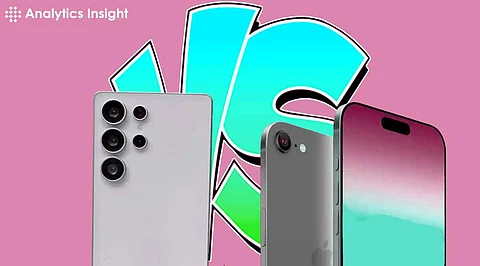

The competition between Samsung and Apple reaches new heights in 2025 with the Samsung Galaxy S25 Ultra and iPhone 17 Air vying for dominance in the premium smartphone market. Both devices showcase the best of technology and innovation, offering distinct features that cater to different user preferences. Here's a comprehensive comparison to help understand how these flagship models stack up against each other.
The Samsung Galaxy S25 Ultra offers a sleek design with dimensions of 77.6 x 162.8 x 8.2 mm and a weight of 219 grams. Its aluminum and glass build, coupled with Corning Gorilla Glass Victus Plus protection, ensures durability while maintaining an elegant look. The curved display and punch-hole design further enhance its modern aesthetic.
The iPhone 17 Air, expected to launch later in 2025, features a more compact design with a 6.1-inch display, smaller notch, and lighter weight. Its aluminum and ceramic shield glass construction ensures robustness, while its water resistance rating of 6 meters for up to 30 minutes underscores Apple's focus on durability.
Samsung’s Galaxy S25 Ultra boasts a 6.9-inch Dynamic AMOLED 2X display with a resolution of 1800 x 3440 pixels and a 144Hz refresh rate. This quad-curved display delivers exceptional sharpness, color accuracy, and smoothness, making it ideal for gaming and multimedia consumption.
The iPhone 17 Air offers a 6.1-inch Super Retina XDR OLED display with a resolution of 1200 x 2600 pixels and a 60Hz refresh rate. While its smaller screen size and refresh rate may seem less impressive on paper, Apple’s True Tone and HDR support ensure vivid visuals and accurate color reproduction.
The Galaxy S25 Ultra is powered by Qualcomm’s Snapdragon 8 Gen 4 chipset, paired with 12GB of RAM and 256GB of UFS 4.0 storage. This hardware combination ensures lightning-fast performance, seamless multitasking, and efficient power consumption. Running on Android 15 with OneUI 7.1, the device offers extensive customization and a user-friendly interface.
The iPhone 17 Air features Apple’s latest octa-core processor, supported by 8GB of RAM and 128GB of storage. Powered by iOS 18, it promises a seamless ecosystem integration, enhanced app performance, and robust security features. Apple’s proprietary chipsets are known for their efficiency and longevity, ensuring smooth operation even after years of usage.
The Galaxy S25 Ultra stands out with its quad-camera setup, featuring a 200MP main sensor, two 50MP sensors (ultra-wide and telephoto), and a 10MP sensor. This array offers unparalleled versatility for photography enthusiasts, including detailed zooming, wide-angle shots, and low-light performance. The 50MP front camera ensures sharp and vivid selfies.
The iPhone 17 Air takes a more minimalist approach with a dual-camera setup. Its 12MP main sensor and 12MP ultra-wide lens are optimized with features like Smart HDR 4, Night Mode, and Deep Fusion. The 24MP front camera excels in delivering high-quality selfies and supports 4K video recording. While the camera specs may seem modest compared to Samsung, Apple's computational photography ensures impressive results.
Samsung’s Galaxy S25 Ultra packs a massive 5500mAh battery, ensuring all-day usage. It supports 45W fast charging, 25W wireless charging, and 10W reverse charging, making it a powerhouse for both productivity and entertainment.
The iPhone 17 Air comes with a 3000mAh battery and supports 15W MagSafe wireless charging. While the battery capacity is smaller, Apple's efficient hardware and software integration optimize power consumption, ensuring comparable battery life.
The Galaxy S25 Ultra supports the latest connectivity options, including Wi-Fi 7, Bluetooth 5.3, and USB-C 3.2. Features like an in-display fingerprint sensor and dual 5G VoLTE enhance its usability.
The iPhone 17 Air introduces satellite connectivity for emergency situations, alongside advanced sensors like crash detection. It supports dual 5G and includes Wi-Fi 7 and Bluetooth 5.4 for seamless connectivity. Apple’s commitment to privacy and security further strengthens its appeal.
The Samsung Galaxy S25 Ultra is expected to launch at ₹1,24,990, reflecting its premium positioning. Its high price tag is justified by its expansive feature set, including top-tier display technology, powerful cameras, and a large battery.
The iPhone 17 Air, with an expected price of ₹79,990, offers a more affordable entry point into the premium smartphone market. While it may lack some of the cutting-edge features of its competitor, its compact design, powerful ecosystem, and reliable performance make it a compelling choice.
The Galaxy S25 Ultra caters to tech enthusiasts, power users, and those who prioritize advanced camera capabilities and multimedia experiences. Its larger display and robust performance make it ideal for gaming and productivity.
The iPhone 17 Air appeals to users seeking a balance between performance and portability. Its integration with Apple’s ecosystem, coupled with its focus on security and user experience, makes it a preferred choice for professionals and Apple loyalists.
The Samsung Galaxy S25 Ultra and iPhone 17 Air represent the pinnacle of smartphone innovation in 2025. While the Galaxy S25 Ultra impresses with its cutting-edge features and expansive capabilities, the iPhone 17 Air excels in delivering a refined user experience within a compact design.
The choice between the two ultimately depends on individual preferences, budget, and ecosystem loyalty. Both devices showcase the relentless innovation driving the smartphone industry forward, ensuring that users have access to the best technology available.
